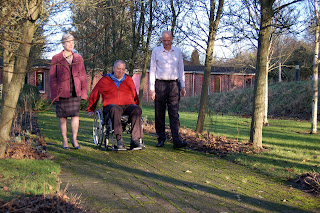The newspapers this week reported on the state of the Nation’s exercise levels. Even when you are used to seeing regular articles on rising obesity levels and falling health indicators, it was still pretty shocking; 20 per cent of us, it seems, have not done any exercise in the last four weeks and 80 per cent do not manage to meet the government’s recommended activity targets.
This latest depressing read comes from research undertaken
by the Centre for Market and Public
Organisation at Bristol University using Sport England’s Active People Surveys.
Sport England’s own analysis of their data focuses on
participation in sport and active recreational activities. We know that
disabled people fare badly here; just 18% of disabled people play sport once a
week, against 35% when the whole adult population is considered.
Through mystery visits at gyms,
we’ve found that equipment can be inaccessible. Although staff were
accommodating and friendly, fitness activity that staff at a gym facility
suggested to the wheelchair user was poor. This suggests that as well as better
equipment, better training and awareness is needed among staff about wheelchair
users. Aspire’s
own research in this area has shown that there is discrimination within the
leisure industry, and a lot of the work out of the Aspire National Training
Centre is aiming to improve things; clearly, there is still a long way to go.
What makes this new study so interesting is that they use
data that Sport England collect but do not themselves break down. Importantly,
this means that we can see how active a lifestyle people lead, even when they
do not participate in organised sports; the study is just as interested in how
often people walk or cycle for non-leisure purposes as it is in how often they
go to the gym or throw a ball around a court.
This shows, amongst other things, that there is a positive
correlation between household income and activity levels; given that disabled
adults are twice as likely to live in low income households as non-disabled
people, it seems it’s not just discrimination and access that needs to be
tackled if we’re to see more disabled people being active. These are barriers
that disabled people face in participating in sport.
But, of course, there’s a flaw here in that if you can’t
walk, the research assumes that you can only be active by taking part in a
“para-sport”. What we’re missing is information on how active manual wheelchair
users are in their day to day lives. Some aspect of the ‘Paralympic Legacy’
should have taught society that the ability to walk is not the be all and end
all of getting around, but there’s more to it than that. As we’ve seen,
disabled people face more challenges than most in accessing formal activities,
so having the lifestyle data for wheelchair users is particularly important.
Aspire finds the ‘Doing
Sport Differently’ report by Disability Rights UK a useful guide for
disabled people in finding ways in which they can be more active in sport and
exercise.
Wheelchair users face all the health disadvantages that come
with being inactive, as well as additional difficulties that come with
transferring and self-propelling the more unfit and heavier they are. The NHS
doesn’t always help, often providing
wheelchairs that are so unsuitable they limit the users’ ability to get out
and about. Knowing to what extent there’s a problem with inactivity, and using
the data to be able to follow the impact of changes or campaigns put in place,
would make a massive difference.
We’ll be writing to Sport England to suggest some changes to
their questionnaire so that wheelchair users are not omitted from the lifestyle
section of their questionnaire. And in the meantime, we’d suggest everyone gets
out for a quick walk or push round their local park this week.

No comments:
Post a Comment